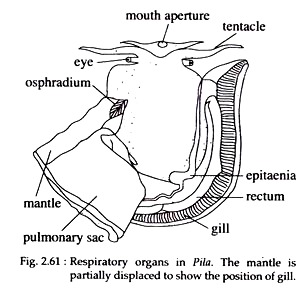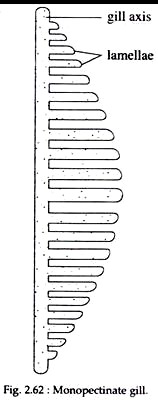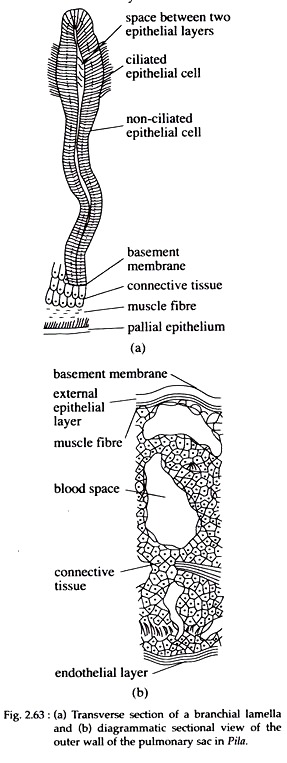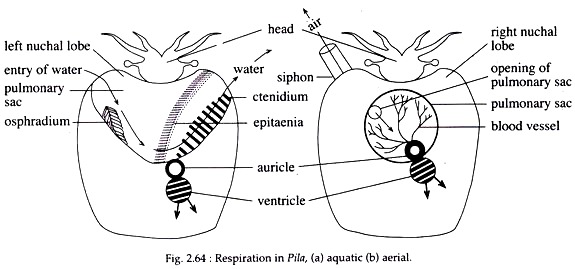In this article we will discuss about the Respiration in Pila:- 1. Respiratory Structures in Pila 2. Mechanism of Aquatic Respiration in Pila 3. Aerial Respiration.
Respiratory Structures in Pila:
Pila commonly known as pond snail or apple snail is a gastropod mollusc. They inhabit fresh water pond and lake. They live most of the time in water but can also thrive well on land. So they are really amphibious in nature and exhibit double mode of respiration i.e., absorb oxygen from water during aquatic respiration and utilize atmospheric air while living on land.
Aquatic Respiration:
Pila performs aquatic respiration by gill.
ADVERTISEMENTS:
Gill:
In Pila a single ctenidium is situated on the dorsolateral wall of the branchial or right chamber of the mantle cavity (Fig. 2.61). The gill consists of numerous triangular lamellae or leaflets, arranged in a single row running parallel to one another along the central axis of the gill. This type of gill is called monopectinate type (Fig. 2.62).
The basal end of each lamella is attached to the pallial epithelium of the mantle wall and the other end hangs freely in the branchial chamber. In the middle of the gill, the lamellae are large in size, while it decreases towards the two ends (Fig. 2.62).
Histologically each branchial lamella is composed of two layers of epithelia supported by muscle fibres and connective tissues.
Each epithelial layer consists of three types of cells:
(i) Ciliated columnar cells,
(ii) Non- ciliated columnar cells and
ADVERTISEMENTS:
(iii) Glandular cells (Fig. 2.63a, b).
Both afferent and efferent blood vessels lying along the axis of the gill supply blood to the lamellae through fine vessels and capillaries. The efferent vessel carries oxygenated blood to the heart.
Mechanism of Aquatic Respiration in Pila:
In aquatic respiration, a current of water containing oxygen is drawn in by the left siphon .into the mantle cavity. The water then flows over the gill by the help of ciliated epithelia. Exchange of gases take place between the water and the blood vessels of gill.
The water is expelled from the mantle cavity through the right siphon. Two fleshy projections over the foot, called nuchal lobes form the respiratory siphon during aquatic respiration in Pila (Fig. 2.64).
Aerial Respiration in Pila:
If the oxygen concentration of water gets reduced, Pila comes out of water and respire by taking in air with the help of pulmonary sac. A comb-like sense organ called osphradium, close to the left nuchal lobe helps the animal to estimate the oxygen concentration in water.
Pulmonary Sac:
The pulmonary sac is a closed cavity hanging from the dorsal wall of the mantle in the pulmonary chamber or left chamber of mantle cavity (Fig. 2.61). The sac has an opening called the pneumostome in the pulmonary chamber — which is guarded by two valves.
ADVERTISEMENTS:
The dorsal wall of the pulmonary sac is highly vascular and helps directly in gaseous exchange. Histologically, the sac is composed of outer epithelial layer, middle muscular and vascular connective tissue layers and inner endothelial layer (Fig. 2.63b).
Mechanism of Aerial Respiration:
It takes place in two ways:
(i) In Water:
Pila can respire through the pulmonary sac while it remains in water. To inhale the atmospheric air, it comes to the surface of the water. It then expands the size of the left nuchal lobe, both in length and breadth and rolls up to form an elongated respiratory tube.
The outer end of the tube extends beyond the level of water and sucks in air from the atmosphere. The inner end of the tube comes in contact with the opening of the pulmonary sac. The alternate contraction and dilation of the mantle wall and the pulmonary sac help in the process of respiration.
Following the exchange of oxygen and carbon dioxide, from air to the blood vessels of pulmonary sac and from blood vessels to air, the expelled air goes out of pulmonary chamber through the respiratory tube. During this exchange, the branchial chamber remains completely separated from the pulmonary chamber by the epitaenia which comes in contact with the roof of the mantle (Fig. 2.64).
(ii) On Land:
During dry season, when the water level gets reduced, or while living on land, Pila does not use any respiratory tubes or siphons. The pulmonary sac directly becomes filled up with atmospheric air to facilitate aerial respiration.
The shell remains closed completely with the help of operculum during the time of aestivation, when Pila respires with the little amount of stored air kept in the pulmonary sac. Hemocyanin, dissolved in plasma acts as the respiratory pigment in Pila.



